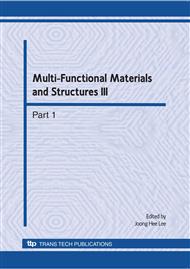p.471
p.475
p.479
p.483
p.487
p.491
p.495
p.499
p.503
Mechanical Property Evaluation of IRM®/Chitosan Fiber Composite Temporary Filling Material
Abstract:
The temporary filling material seals up the tooth cavity so as to prevent bacterial leakage and the second infection in the root-end treatment. Chitosan is biodegradable, bio-resorbable, non-toxic, and antibiotic. In this study, chitosan fiber is used to enhance the temporary filling material compressive strength and the tooth bite force. IRM® is reinforced by the 2, 4 and 6 wt% chitosan fibers, respectively. And after solidified the IRM®/ Chitosan fiber composite temporary filling material was obtained. Then setting time, solution test, compressive strength and dye micro-leakage of IRM®/ Chitosan fiber composite temporary filling material were be evaluated. In result, maximum compressive strength of IRM®/ Chitosan fiber composite temporary filling material was obviously increased 200 N than IRM® matrix. As to the micro-leakage test, no trace of leakage was found on the 7th day. Consequently, IRM®/ Chitosan fiber composite temporary filling material can be a good candidate in the short-term dental clinical surgery.
Info:
Periodical:
Pages:
487-490
Citation:
Online since:
August 2010
Authors:
Keywords:
Price:
Сopyright:
© 2010 Trans Tech Publications Ltd. All Rights Reserved
Share:
Citation:


